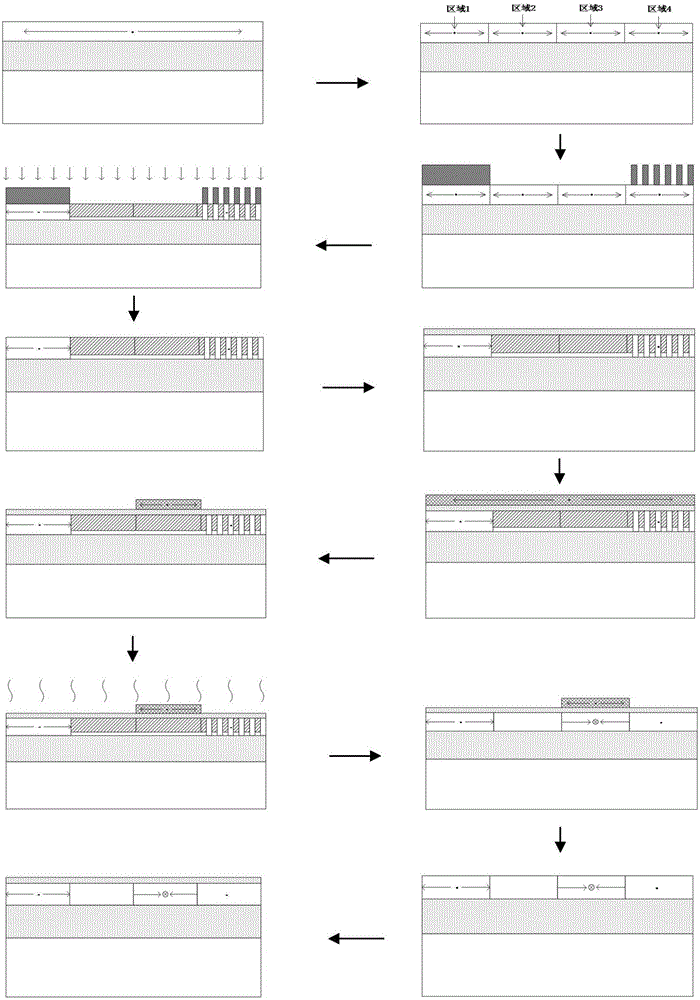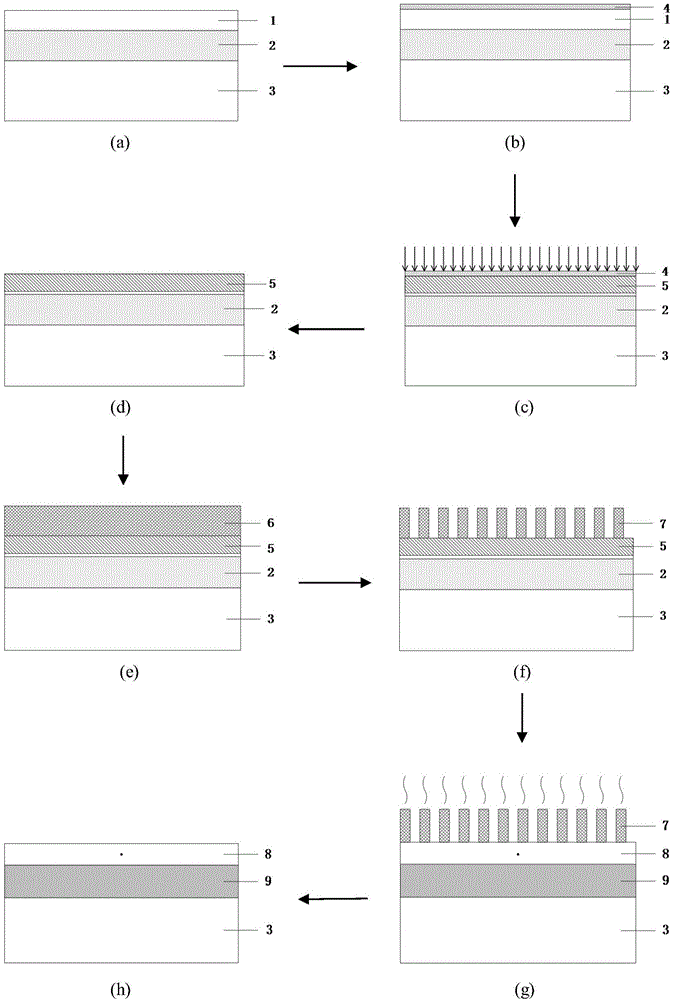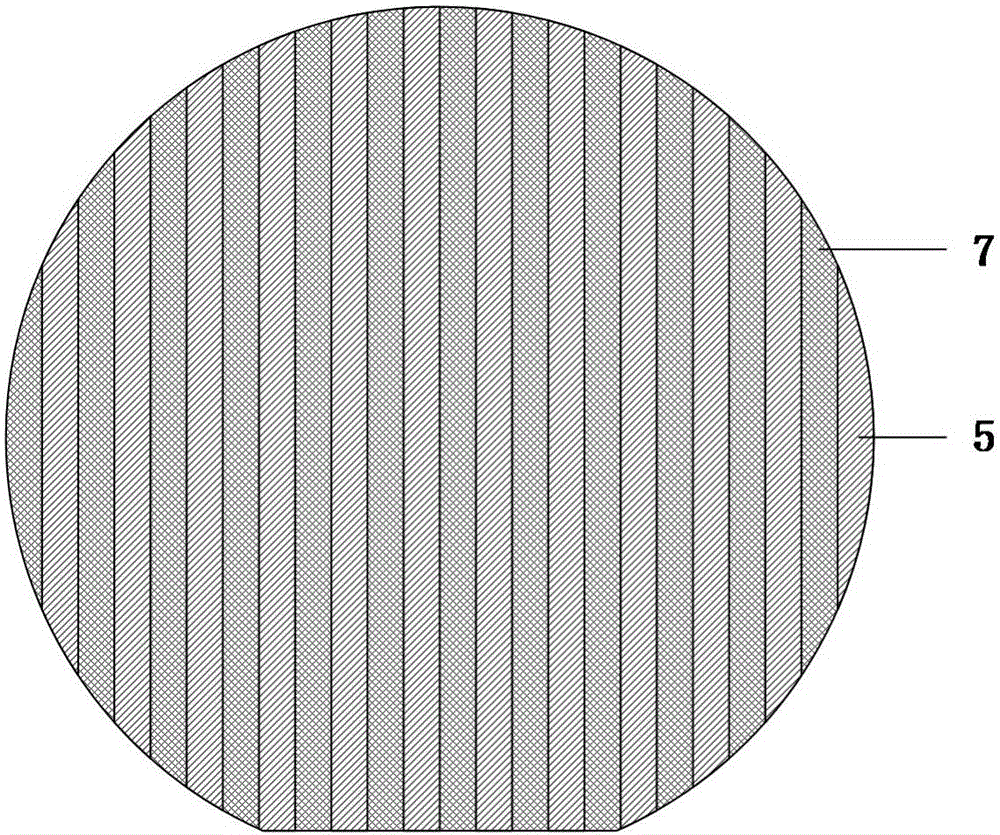Fabrication method for wafer-level mono-axial strain Si on AlN-buried insulation layer based on non-crystallization and scale effect
A uniaxial strain technology on an insulating layer, applied in the field of microelectronics, can solve the problems of non-adjustment, easy breakage, high cost, avoid damage and defects, improve insulation and heat dissipation, and improve material performance.
- Summary
- Abstract
- Description
- Claims
- Application Information
AI Technical Summary
Problems solved by technology
Method used
Image
Examples
Embodiment 1
[0051] Example 1, making a wafer-level uniaxial tensile-strained Si material on a 5-inch AlN buried insulating layer.
[0052] Step 1: Select a 5-inch Si wafer on an AlN-buried insulating layer and clean it.
[0053] (1a) Use acetone and isopropanol to alternately perform ultrasonic cleaning on the Si wafer on the selected AlN buried insulating layer to remove organic contamination on the substrate surface;
[0054] (1b) Prepare a mixed solution of ammonia water, hydrogen peroxide, and deionized water in a ratio of 1:1:3, heat to 120°C, soak the Si wafer on the AlN-buried insulating layer in the mixed solution for 12 minutes, take it out and use Rinse with a large amount of deionized water to remove inorganic pollutants on the surface of the Si wafer on the AlN buried insulating layer;
[0055] (1c) Soak the Si wafer on the AlN buried insulating layer with HF acid buffer for 2 minutes to remove the oxide layer on the surface.
[0056] Step 2: Deposit SiO 2 Layer 4, such as ...
Embodiment 2
[0083] Example 2, manufacturing a wafer-level uniaxial tensile strained Si material on a 6-inch AlN buried insulating layer.
[0084] Step 1: Select a 6-inch Si wafer on an AlN-buried insulating layer and clean it.
[0085] The implementation of this step is the same as step 1 of Embodiment 1.
[0086] Step 2: Take out the Si wafer on the AlN buried insulating layer after cleaning, and deposit SiO on the top Si layer 1 by plasma-enhanced chemical vapor deposition PECVD process 2 layer, that is, the SiH 4 The flow rate is 45sccm, N 2 O flow is 164sccm, N 2 The flow rate is 800sccm, the gas pressure is 600mTorr, the power is 60W, and the deposition temperature is 300°C, and the SiO with a thickness of 16nm is deposited. 2 Layer 4, such as figure 2 (b) shown.
[0087] Step 3: Use an ion implanter to implant a dose of 3E15cm into the top Si layer 1 -2 , the energy is 60keV, Si ions to form an amorphous layer 5 inside the top Si layer 1, such as figure 2 (c) shown.
[0088...
Embodiment 3
[0098] Example 3, fabricating a wafer-level uniaxial compressively strained Si material on an 8-inch AlN buried insulating layer.
[0099] Step A: select an 8-inch Si wafer on an AlN buried insulating layer, and clean it.
[0100] The implementation of this step is the same as step 1 of Embodiment 1.
[0101] Step B: Deposit SiO 2 Layer 4, such as figure 2 (b) shown.
[0102] Take out the Si wafer on the AlN buried insulating layer after cleaning, and deposit SiO with a thickness of 25 nm on the top Si layer 1 by plasma enhanced chemical vapor deposition PECVD process. 2 Layer 4, prevents "channeling" from occurring, such as figure 2 (b) shown.
[0103] The deposition process is as follows: SiH 4 The flow rate is 45sccm, N 2 O flow is 164sccm, N 2 The flow rate is 800 sccm, the gas pressure is 600 mTorr, the power is 60 W, and the deposition temperature is 300° C.
[0104] Step C: forming an amorphized layer 5, such as figure 2 (c) shown.
[0105] Form SiO 2 Aft...
PUM
| Property | Measurement | Unit |
|---|---|---|
| thickness | aaaaa | aaaaa |
| width | aaaaa | aaaaa |
Abstract
Description
Claims
Application Information
 Login to View More
Login to View More - R&D
- Intellectual Property
- Life Sciences
- Materials
- Tech Scout
- Unparalleled Data Quality
- Higher Quality Content
- 60% Fewer Hallucinations
Browse by: Latest US Patents, China's latest patents, Technical Efficacy Thesaurus, Application Domain, Technology Topic, Popular Technical Reports.
© 2025 PatSnap. All rights reserved.Legal|Privacy policy|Modern Slavery Act Transparency Statement|Sitemap|About US| Contact US: help@patsnap.com



